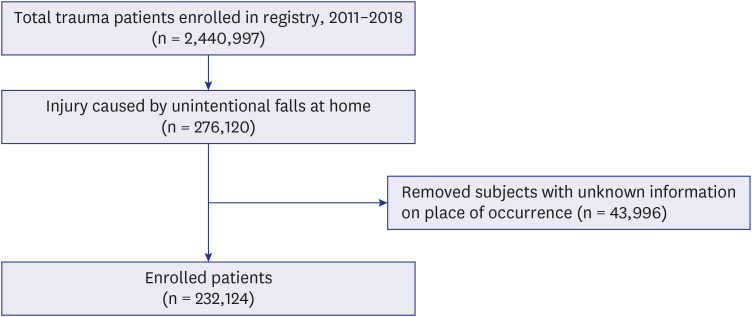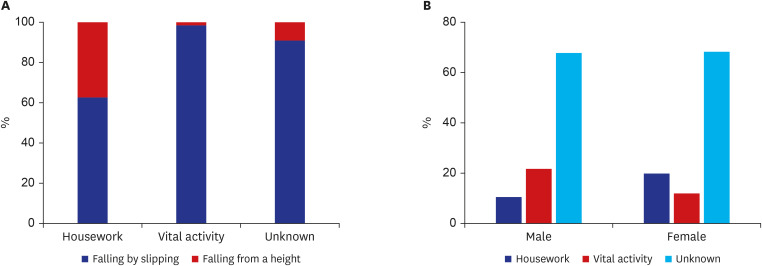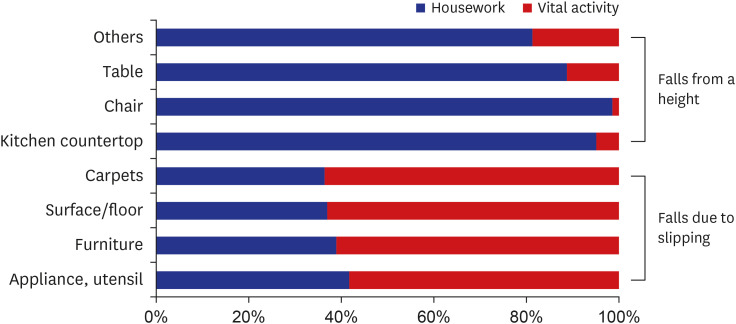J Korean Med Sci.
2021 Feb;36(7):e53. 10.3346/jkms.2021.36.e53.
Risk Factors for Intracranial Injury Caused by Falls at Home in Korea Using Data from the Emergency Department-based Injury In-depth Surveillance (2011–2018)
- Affiliations
-
- 1Department of Emergency Medicine, Hallym University Dongtan Sacred Heart Hospital, Hwaseong, Korea
- 2Department of Emergency Medicine, Hallym University Kangdong Sacred Heart Hospital, Seoul, Korea
- 3Department of Emergency Medicine, Korea University College of Medicine, Seoul, Korea
- 4Department of Epidemiology, School of Public Health, Seoul National University, Seoul, Korea
- KMID: 2513075
- DOI: http://doi.org/10.3346/jkms.2021.36.e53
Abstract
- Background
Most unintentional injuries that occur at home are preventable. However, it may be difficult to sufficiently reduce the number of falls occurring at home by only identifying risk factors focused on specific age groups. Therefore, this study aimed to identify the risk factors (especially age and places where injuries occurred at home) for intracranial injury (ICI) caused by unintentional falls at home.
Methods
Using the Emergency Department (ED)-Based Injury In-depth Surveillance, we analyzed the data of patients who visited the ED due to unintentional falls at home. Risk factors were identified using multivariable logistic regression according to age groups and interactions between place of injury occurrence and age groups, and sex and age groups were assessed.
Results
In total, 232,124 patients were included in the analysis; older adults had a higher adjusted odds ratio (aOR) 14.05 (95% confidence interval [CI], 12.74–15.49) of ICI than infants. The corridor was associated with ICI in the male pediatric group (aOR, 2.71; 95% CI, 1.08–6.84) and the balcony with the female pediatric group (aOR, 2.04; 95% CI, 1.03–4.04). In the adult group, aOR of kitchen was 1.38 (95% CI, 1.02–1.88) in females and 0.56 (95% CI, 0.48–0.66) in males.
Conclusion
In this study, we identified the risk factors of ICI caused by falls at home using ED-based injury surveillance data. The risk of ICI was different among places of occurrence in the home depending on the age groups and sex.
Keyword
Figure
Reference
-
1. Injury Facts. All injuries: overview. Updated 2020. Accessed April 2020. https://injuryfacts.nsc.org/all-injuries/overview/.2. Angermann A, Bauer R, Nossek G, Zimmermann N. Injuries in the European Union: Statistics Summary 2003–2005. Wien: Austrian Road Safety Board;2007.3. Lord SR, Ward JA, Williams P, Anstey KJ. Physiological factors associated with falls in older community-dwelling women. J Am Geriatr Soc. 1994; 42(10):1110–1117. PMID: 7930338.
Article4. Tinetti ME, Kumar C. The patient who falls: “It's always a trade-off”. JAMA. 2010; 303(3):258–266. PMID: 20085954.5. Rubenstein LZ. Falls in older people: epidemiology, risk factors and strategies for prevention. Age Ageing. 2006; 35(Suppl 2):ii37–41. PMID: 16926202.
Article6. Division of Health Promotion and Disease Prevention, Institute of Medicine (US). Berg RL, Cassells JS. Falls in older persons: risk factors and prevention. The Second Fifty Years: Promoting Health and Preventing Disability. Washington, D.C.: National Academies Press (US);1992. p. 263–290.7. Ambrose AF, Paul G, Hausdorff JM. Risk factors for falls among older adults: a review of the literature. Maturitas. 2013; 75(1):51–61. PMID: 23523272.
Article8. Choi NG, Choi BY, DiNitto DM, Marti CN, Kunik ME. Fall-related emergency department visits and hospitalizations among community-dwelling older adults: examination of health problems and injury characteristics. BMC Geriatr. 2019; 19(1):303. PMID: 31711437.
Article9. Wadhwaniya S, Alonge O, Ul Baset MK, Chowdhury S, Bhuiyan AA, Hyder AA. Epidemiology of fall injury in rural Bangladesh. Int J Environ Res Public Health. 2017; 14(8):900.
Article10. Harris VA, Rochette LM, Smith GA. Pediatric injuries attributable to falls from windows in the United States in 1990-2008. Pediatrics. 2011; 128(3):455–462. PMID: 21859909.
Article11. Zielinski AE, Rochette LM, Smith GA. Stair-related injuries to young children treated in US emergency departments, 1999-2008. Pediatrics. 2012; 129(4):721–727. PMID: 22412031.
Article12. Kendrick D, Maula A, Reading R, Hindmarch P, Coupland C, Watson M, et al. Risk and protective factors for falls from furniture in young children: multicenter case-control study. JAMA Pediatr. 2015; 169(2):145–153. PMID: 25436605.13. Ibrahim NG, Wood J, Margulies SS, Christian CW. Influence of age and fall type on head injuries in infants and toddlers. Int J Dev Neurosci. 2012; 30(3):201–206. PMID: 22079853.
Article14. Lyons RA, Sander LV, Weightman AL, Patterson J, Jones SA, Rolfe B, et al. Modification of the home environment for the reduction of injuries. Cochrane Database Syst Rev. 2003; (4):CD003600. PMID: 14583986.
Article15. Ahn SH, Seo SH, Kim BA, Lee KE, Kim YT. Emergency department-based injury in-depth surveillance data, 2006-2015. Public Health Wkly Rep. 2016; 9(33):650–654.16. Park GJ, Shin J, Kim SC, Na DS, Lee HJ, Kim H, et al. Protective effect of helmet use on cervical injury in motorcycle crashes: a case-control study. Injury. 2019; 50(3):657–662. PMID: 30765183.
Article17. ICECI Coordination and Maintenance Group. International Classification of External Causes of Injuries (ICECI) version 1.2. Updated 2004. Accessed April 1, 2020. https://www.whofic.nl/sites/default/files/2018-05/ICECI%20in%20English.pdf.18. Kim J, Shin SD, Im TH, Lee KJ, Ko SB, Park JO, et al. Development and validation of the excess mortality ratio-adjusted injury severity score using the International Classification of Diseases 10th Edition. Acad Emerg Med. 2009; 16(5):454–464. PMID: 19388920.
Article19. Park JM, Park YS, Park I, Kim MJ, Kim KH, Park J, et al. Characteristics of burn injuries among children aged under six years in South Korea: Data from the Emergency Department-Based Injury In-Depth Surveillance, 2011-2016. PLoS One. 2018; 13(6):e0198195. PMID: 29883475.
Article20. Campbell AJ, Borrie MJ, Spears GF, Jackson SL, Brown JS, Fitzgerald JL. Circumstances and consequences of falls experienced by a community population 70 years and over during a prospective study. Age Ageing. 1990; 19(2):136–141. PMID: 2337010.
Article21. Ngamsangiam P, Suttanon P. Risk factors for falls among community-dwelling elderly people in Asia: a systematic review. Sci Technol Asia. 2020; 25(3):105–126.22. Stevens JA, Mahoney JE, Ehrenreich H. Circumstances and outcomes of falls among high risk community-dwelling older adults. Inj Epidemiol. 2014; 1(1):5. PMID: 27747670.
Article23. Gillespie LD, Robertson MC, Gillespie WJ, Sherrington C, Gates S, Clemson LM, et al. Interventions for preventing falls in older people living in the community. Cochrane Database Syst Rev. 2012; (9):CD007146. PMID: 22972103.
Article24. Stevens JA, Haas EN, Haileyesus T. Nonfatal bathroom injuries among persons aged ≥15 years--United States, 2008. J Safety Res. 2011; 42(4):311–315. PMID: 22017838.25. Gaw CE, Chounthirath T, Smith GA. Nursery product-related injuries treated in United States emergency departments. Pediatrics. 2017; 139(4):e20162503. PMID: 28289137.
Article26. Haarbauer-Krupa J, Haileyesus T, Gilchrist J, Mack KA, Law CS, Joseph A. Fall-related traumatic brain injury in children ages 0-4 years. J Safety Res. 2019; 70:127–133. PMID: 31847987.
Article27. Latham NK, Anderson CS, Lee A, Bennett DA, Moseley A, Cameron ID, et al. A randomized, controlled trial of quadriceps resistance exercise and vitamin D in frail older people: the Frailty Interventions Trial in Elderly Subjects (FITNESS). J Am Geriatr Soc. 2003; 51(3):291–299. PMID: 12588571.
Article28. Nordell E, Jarnlo GB, Jetsén C, Nordström L, Thorngren KG. Accidental falls and related fractures in 65-74 year olds: a retrospective study of 332 patients. Acta Orthop Scand. 2000; 71(2):175–179. PMID: 10852324.
Article29. World Health Organization. Falls. Updated 2018. Accessed June 19, 2020. https://www.who.int/news-room/fact-sheets/detail/falls.
- Full Text Links
- Actions
-
Cited
- CITED
-
- Close
- Share
- Similar articles
-
- A Preliminary Application of an Emergency Department-based Indepth Injury Surveillance System
- Severe Injuries from Low-height Falls in the Elderly Population
- Comparison of pediatric injury patterns before and during the COVID-19 pandemic in Korea: a retrospective study
- Factors associated with injury severity among users of powered mobility devices
- A Preliminary Study of an Emergency Department-based In-depth Injury Surveillance System of Preschool Children Injury




